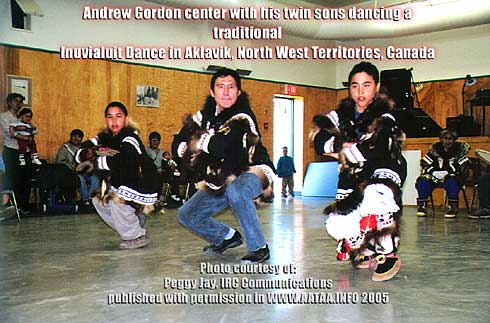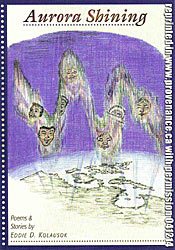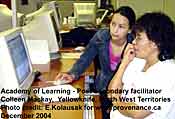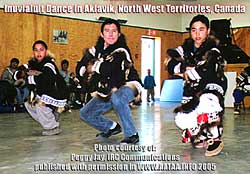Inuvialuit Drumming and Dancing
Kept Alive by Elders, Adults and Youth Working Together
By: Eddie Kolausok
Yellowknife - 2005
Since time immemorial the Inuvialuit of the Canadian Western Arctic have been preserving their history and culture through various oral traditions. One of the dynamic and exciting traditions that have helped preserve Inuvialuit culture and history is their song and dance. The songs and dances of the Inuvialuit, however, were almost exterminated at the turn of the century. This is a brief overview of how the songs and dances of the Inuvialuit of Aklavik, Inuvik and the Beaufort Delta were preserved.
At the turn of the century the Inuvialuit population was reduced by over 95% from a high of approximately 2500 people to 150 remaining in 1910. The demise of the population was caused by diseased which were introduced by American whalers who arrived in the Western Arctic in 1889 and left when the whaling industry collapsed around 1908. The Inuvialuit population began to rebuild as Inuvialuit intermarried with Inupiat Inuit from Alaska as other Inuit from the east as well as with newcomers, whalers that remained, incoming trappers and their Gwich'in neighbors. Inuvialuit means, "the real people," and when the new Inuvialuit population began to rebuild, the real people became a people that identified with their ancestors culture and traditions but now had a full mixture of global humanity running through their communities.
One difficult blemish on Inuvialuit history is when the missionaries entered Inuvialuit territory and took on a role of educating Inuvialuit children. At first the services of education, health and social services were seen as needed to help the people survive. But like many good intentions, serious cultural and social implications would be a result when assimilation practices were incorporated into the daily lives of residential school children. When children were taken out of their families for many years and not allowed to speak their own languages, serious social dislocations to the language and culture would erode the Inuvialuit identity. The first generation of Inuvialuit to experience large scale social engineering through the discrimination of not allowing their children to speak their own language at school happened in the late 1920s and early 1930's. Inuvialuit children that entered residential schools in the 1940s, 50's, 60's and by the 1970's were losing their language rapidly as the English language took precedence over local languages. Inuvialuit elders maintained their language and worked hard to pass on their language to their children but faced with the assimilation and paternalistic policies of the Canadian government, their efforts were largely undermined.
The Inuvialuit are resilient people and they adapted to the fur trade very easily and later to the wage economy that was introduced largely by the Dew-Line construction years of the Cold War era. The Cold War era after World War II saw an intense interest in the North for security and sovereignty reasons. Soon Canada began to create a presence in the North on a large scale. Inuvik was created as a model northern town in 1958 and all of the residents of Aklavik were offered an opportunity to relocate which many took but many also refused. Soon government jobs, oil exploration, and a host of transportation and construction related jobs provided more secure wage opportunities than the insecure fur trade industry. As the fur trade was crushed by animal rights groups and others concerned with the welfare of animals, Inuvialuit turned in large numbers to other opportunities but most still harvested a large part of their food from the land and sea. Others also still continued with the hunting and trapping life they favored over community life but it provided a limited income.
Throughout these changes the powerful songs and stories of the Inuvialuit were maintained by elders who continued to sing and dance despite the serious social dislocations that their people were experiencing. In Aklavik, Tuktoyaktuk, Holman, Paulatuk, Sachs Harbor and Inuvik, elders continued to teach their youth the history and stories embodied in their traditional songs and dances. In Aklavik elders such as Amos Paul, Simon Bennett, Kathleen Hansen, Hope and Alex Gordon among others were a drumming and dancing force that held onto their ancestor's traditions and passed this important tradition onto their youth. Andrew Gordon a member of the Aklavik Drummers and Dancers remembers this time as he states, "we were taught by our parents and elders and we taught our youth to sing and dance as well."

Click to return to top of article
I also remember well the times when Inuvialuit people congregated in Gardlund's Theater in Aklavik to the joy of a good drum dance. As a young child I was mesmerized by the singing and beautiful traditional clothing, head dresses and long tasseled gloves worn by the elders as they danced. The men would do various dances that told stories of hunting, whaling, fishing and hard times as well as good times. It was always good to see that both women and men drummed, sang and danced. It really showed the strength of equality and when the children joined in as we often did with smiles of joy and happiness on our faces, it was pure traditional magic.
Today the drums of the Inuvialuit are very much alive and the songs and dances that accompany them can be heard in all Inuvialuit communities due to the resilient efforts of elders, adults and youth working together. As Andrew and his wife Eva watch their twin boys carry on the Inuvialuit tradition of drumming and dancing it makes them feel happy, as Andrew states, "it makes us feel good seeing them perform."
Aataa.info recognizes the hard work and great contribution that the Inuvialuit elders, adults and youth are making through preserving their culture and heritage through their songs and dances. By working together you continue to make our communities and world a better place. By passing on your rich heritage you continually empower an ancestral purpose in all and keep the spice of diversity that is Canada's gift to the world continually enriching all. Aataa congratulates all Inuvialuit for their excellent efforts in preserving the songs and dances of their ancestors.
By: By Eddie Kolausok
Yellowknife, Northwest Territories, Canada
© E. Kolausok 2005
******************
"Aataa" is a Siglit Inuvialuit word. Aataa means, "took it from one place to another".
In other words: Aataa.info is a forum for Arctic meta-communication, ie. communicating about native-indigenous Arctic communications modes - through · words · pictures · icons · artwork · 1st nations languages.
The aataa.info website is about sharing. Sharing stories, ideas, poems, information, languages, culture, art, literature, history, trading, selling and inspiring others is what aataa is about.
Credits and Copyright
The content on this site remains the property of its creators and we have received permission to reprint-digitize-tell-share what we have on this site.
Some content on this site as well as links to other web sites / web pages are given as a public service. Aataa.info assumes no responsibility for the accuracy or reliability of information on sites that we link to - however - at the time the links were/are made our editors have made a decision that the information is "useful" and "interesting" for web viewers seeking other sources of information about some aspect of Canada's Arctic people, culture and life.
If you note any errors or omissions in quotes on this site, please email us with the reference in question.
© 2004-2005
www.AATAA.info home page
Other Arctic Canada Info Resources
- Government Information & Related Reference Sites
- Nunavat Government
www.gov.nu.ca - Territorial Government
NorthWest Territories
www.gov.nt.ca
Yukon
www.gov.yk.ca - Aboriginal
- Land Claims
- Canada Federal Government
- CanadaLegal.info
- Nunavat Government
- Laws
- Courts & Lawyers
- Libraries
- Arctic Tourism
- Arctic Business & Commercial Services


